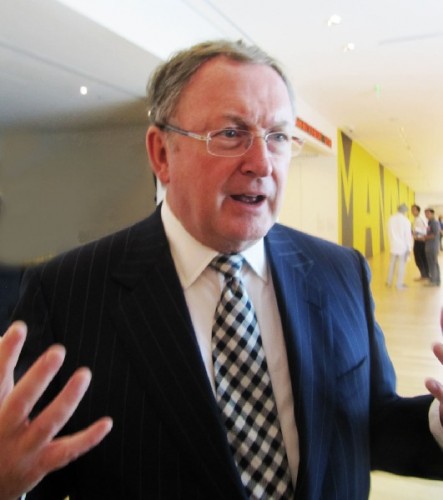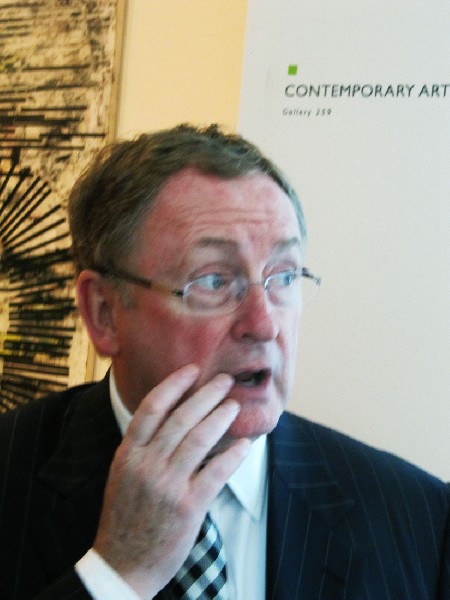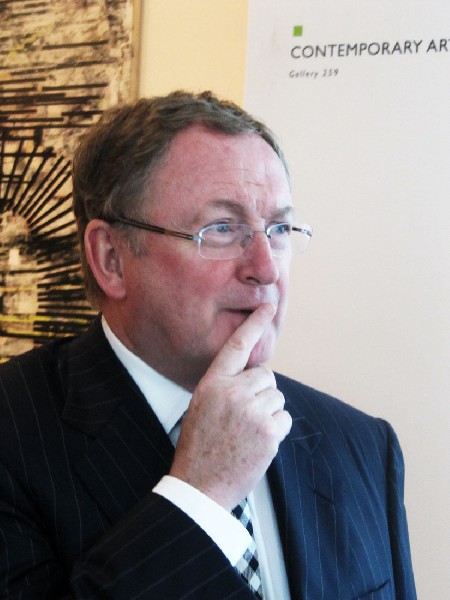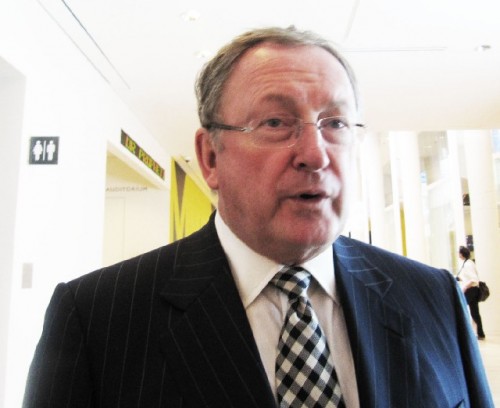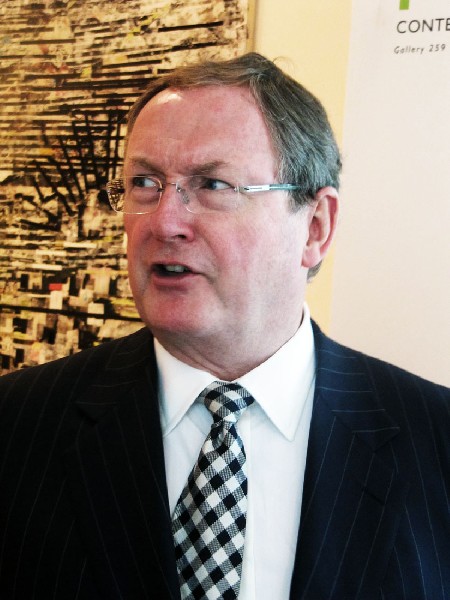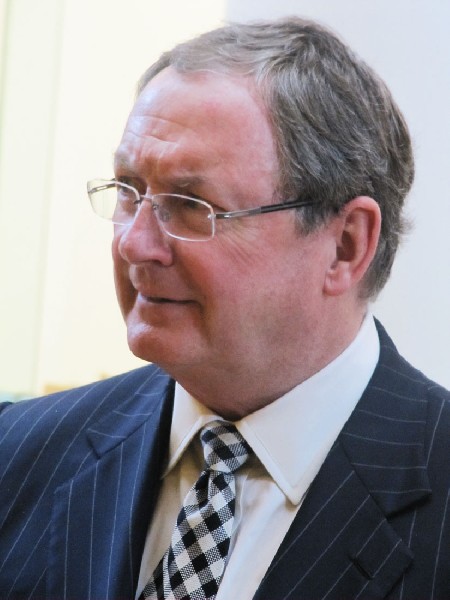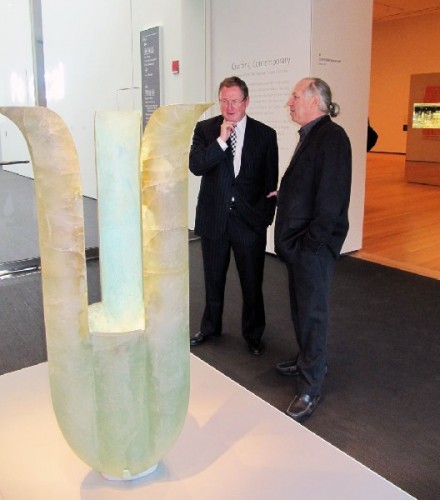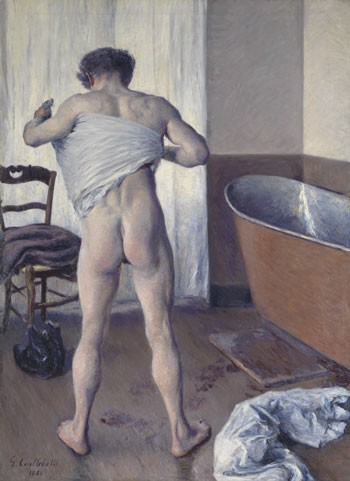Malcolm Rogers on Contemporary Art
No Longer an Oxymoron for the MFA
By: Malcolm Rogers and Charles Giuliano - Sep 21, 2011
Charles Giuliano Is there anything left to do?
Malcolm Rogers The museum is like one of those huge bridges. You start painting at one end and by the time you reach the other end it’s time to start all over again.
CG You’ve had so many projects.
MR I like new things. What a privilege it is to be here during a time of transformation for the museum.
CG How long have you been here?
MR Sixteen or seventeen years I can’t remember. I’m about the fourth longest serving director.
CG In terms of bricks and mortar also one of the most significant.
MR When you think of it for a museum of this size to have transformed every single façade in a period of four or five years.
CG Let’s talk about contemporary art. This was the major museum which was famous for not having any.
MR We’ll have to see what you think. It’s definitely new.
CG What have you acquired in the past few years?
MR There’s a lot that we’ve acquired. But I’ve also said there’s a real culture of collectors in town that’s growing up. People are backing purchases. So Boston is in a process of exciting change.
CG How did that come about? Boston historically has been a city that didn’t have an interest in contemporary art.
MR It has gradually been gaining momentum. If you think about all the institutions there are in town. Think of the influence of the new ICA.
CG Are you going to work together?
MR Of course. If you look at the labels on the walls you will see that many of the benefactors are supporters of the ICA and the MFA.
(In 1988 the MFA and ICA jointly presented The BiNational: Art of the Late '80s in cooperation with the Stadtische Kunsthalle and the Kunstsammlung Nordrhein-Westfalen of Dusseldorf and with support from the Mass. Council on the Arts and Humanities, AT&T Foundation and the National Endowment for the Arts. David Ross was then director of the ICA. The MFA team included Theodore E. Stebbins, Jr. curator of American Art, and Amy Lighthill, curator of contemporary art.)
CG In New York there has been an interesting relationship between MoMA and the Met. When works in the MoMA collection morph from contemporary and modernist to historic some of that material gets transferred to the Met. The ICA is starting to collect but has little or no space to store more than a token of work. In a generation or so it will reach a critical mass and perhaps a crisis point. Can you see some of that work finding its way to the MFA using the model of MoMA and the Met?
MR We don’t have that relationship at the moment. We have art going back thousands of years. When things grow older they become just as attractive to us.
(Under former ICA director Thomas Messer (Born 1919) the Institute abandoned its failed home on Soldier’s Field Road (under founder James Plaut, 1912-1996) and for a time occupied the second floor of the Museum School. There was a plan for the ICA to merge as a department of the MFA with Messer as its curator. That was nixed when Perry T. Rathbone (1911-2000), who had his own ideas about modern art, became director. During the time prior to the collapse of the plan Messer advised the museum on acquisitions of major works by Karel Appel, David Park and Nicolas de Staël. These works are not currently on view.)
CG What is your own definition of contemporary art.
MR My own, very personal definition is anything that was produced during the lifetime of the oldest person in the room.
(The MFA’s Linde Family Wing for Contemporary Art includes Claude Monet’s "La Japonaise" (Camille Monet in Japanese costume), 1876, as a conceptual aspect of a work by Louise Lawler. And “Rape of the Sabine Women” by Picasso, 1963. It was acquired from the artist during a studio visit by Rathbone and his consigliore, Hanns Swarzenski, [Peter], 1903-1985. Hanns was the likely bag man in the scandal of an alleged Raphael portrait of the juvenile "Eleonora Gonzaga." The painting was returned to Italy from which it had been smuggled and brought the curtain down on Rathbone’s tenure at the MFA (1955-1972). Even using Roger’s definition of “contemporary” the “late period” Picasso and Monet look exceedingly odd in the Linde Wing.)
CG That’s an interesting definition. I haven’t heard that before.
MR I think there is too much emphasis on cutting edge and bleeding edge and wet paint. But I think it should be the art of a generation.
CG The issue is that contemporary art has evolved beyond the object with installations and the epic scaled works that we see on the global circuit of biennials. Much of that work just simply can’t be housed in the galleries of the MFA. So we are only viewing the object oriented slice of contemporary art? Has that informed the mandate of what is contained here?
MR I think we have some pretty ambitious installation pieces here. When we are acquiring something we have to ask will it stand the test of time artistically? Is it conservationally sound? Will it last? Does it stand a chance of coming out historically?
CG I go back to when Pollock’s masterpiece “Lavender Mist” was in the Trustees’ Room to be considered for acquisition. The committee was concerned and asked for an opinion by Bill Young who ran the conservation lab. They asked what he could do if some of the spattered paint flaked off. Never having been presented with that problem Young stated that he didn’t know. The MFA passed on acquiring the work from the collector Alfonso A. Ossorio (1916–1990). (He was a friend of the artist and neighbor on Long Island.) It was acquired not long after that by the National Gallery. So those concerns about conservation can work against you.
MR It can. You’ve also got to show imagination. You’ve got to love the subject. That sometimes allows you to make risky choices. Contemporary art is about risky choices to some extent.
CG How do you preserve an Anselm Kiefer? You have one actually.
MR Yes, we do have one with straw built into it. Conservation is very difficult.
CG That was a risky piece when it was acquired (by Theodore E. Stebbins, Jr.).
MR I’m not saying we’ll stop taking risks. I think you will see some risks around the walls. There are some things that are very conservative and quite New England.
CG Is this a good day for you Malcolm?
MR It’s an exciting day. I always love to see a project coming to fulfillment. The truth is it’s never complete. This leads on to other opportunities. I’m particularly happy because everyone involved in this project, it wasn’t a huge budget, everyone has a real sense of joy and achievement in the project.
CG Particularly having works to put on the wall and not fall flat on your face. Why has this historically been such a problematic aspect of the MFA’s collection?
MR We are what people in Boston collect. To a very large extent. Certainly, people from other cities are giving us art. In truth a city collection like this is a reflection of its donors. The taste in Boston has been fundamentally conservative. Now things are perking up.
CG Of course in the 19th century, during the era of French Impressionism, Bostonians were progressive and made great acquisitions.
MR That’s absolutely right.
CG Then it tapered off in the 1920s.
MR Yes, so we are in a way a reflection of the taste and mood of our city. This is an exciting time.
CG What happened when the focus of the Boston art world turned to immigrants in the 1920s and the Depression years of the 1930s? Boston collectors and the MFA passed on the era of the Boston Expressionists
(Karl Zerbe, Jack Levine, Hyman Bloom, and their followers among faculty and students of the Museum School. During a conversation with Ellsworth Kelly during the Linde opening he discussed studying with Zerbe at the Museum School.)
MR You know that these are artists whom we have on display in the museum.
(A Bloom “Cadaver” came with the Lane Collection. Before that the museum owned a small work “The Christmas Tree.” The MFA does not own a major work by Levine and only token work by Zerbe.)
CG Not in significant abundance.
MR Just remember we are one of the world’s great encyclopedic museums. We have to have a bit of everything. We can’t be a museum of New England. We work as hard as we can for New England artists as well. Just look around.
CG You have depth in Copley. The interest in contemporary Boston art tapered off from the 1920s until only comparatively recently. During the 1920s the Brahmin Boston Impressionists like The Ten were phasing out and the immigrant Boston Expressionists were coming in. It is precisely when the mainstream of Boston lost interest not just in Boston artists but also passed on Post War abstract expressionism, pop, minimalism and other contemporary movements. Are you now picking up and coming back to multi-culturalism?
MR As you know multi-culturalism is an important theme in any encyclopedic museum.
(As is evident in the diversity of the artists and works by gender and race in the Linde Wing.)
We’re conscious that work has to be done in the Twentieth Century and in the contemporary period. You’ll see in these galleries a statement of good intentions. Some achievement. More still to do.
CG A way to go.
MR There’s always a way to go. There’s always a way to go.
CG Are you under pressure for that? What is your relationship with the National Center for African American Artists and the MFA’s adjunct curator, Barry Gaither?
MR It’s good. We see Barry here a lot. He works very actively with the museum. So it’s a source of great interest to us. Watch this space. You’ll hear news of interesting acquisitions. What we are presenting here is a salad bar of things you will love and things you won’t. The idea is to provoke discussion.
(Re "Watch This Space" the museum has just announced plans to acquire "Man at His Bath" by the French Impressionist Gustave Caillebotte (19 August 1848 – 21 February 1894.) Caillebotte's sizable allowance, along with the inheritance he received after the death of his father in 1874 and his mother in 1878, allowed him to paint without the pressure to sell his work. He funded Impressionist exhibitions and supported Claude Monet, Auguste Renoir, and Camille Pissarro among others by purchasing their works and, at least in the case of Monet, paying the rent for their studios. He bought his first Monet in 1876. He played a major role in persuading the Louvre to purchase Manet’s "Olympia." To purcahse the Caillebotte, a major work by the artist (a still life is already in its collection) the museum is selling expendable works, some worth millions, by Alfred Sisley, Maxime Camille Louis Maufra, Paul Gauguin, Claude Monet, Pierre-Auguste Renoir, and Camile Pissarro. To acquire Jackson Pollock's "Troubled Queen" (1945) from Mr. And Mrs. Stephen Hahn, the museum traded with a dealer for two works by Renoir, a small painting, “Girl Reading,” (one of the best selling post cards in the museum gift shop at the time), a pastel, “Woman with Black Hair,” and a Monet landscape, “Autumn at Jeufosse.”)
CG Is there anything you are particularly pleased with?
MR What I am particularly pleased with, which benefits the whole of Boston, is that Boston is acquiring collectors of contemporary art. They are prepared to work with more than one institution which I feel is critical. It creates a scene here. Looking historically at what you will see here today I am particularly pleased by the acquisition of a major work by Ellsworth Kelly. It’s something we lacked and he is one of the greatest alumni of the Museum School.
CG Can you ever fill the gaps?
MR I would like to fill the gaps. There will still be opportunities to fill gaps in the next decades. As work is reassessed and things come on the market. Collections break up. We’ll be active.
CG This week MoMA is opening a deKooning exhibition which, with works valued at more than a billion dollars, is the most expensive project the museum has ever undertaken.
MR We just acquired our first deKooning painting actually. It’s a comparatively small work but a beautiful head study. But perhaps one day deKooning’s prices may come down and we’ll have an opportunity.
(Which of course is the price one pays when museums ignore or fail to keep up with artists and movements while they are affordable.)
CG I doubt that.
MR We won’t bet on the market.
CG Ok. Thanks Malcolm for your time.
Contemporary Art in Boston, an Overview
Mark Favermann on the Linde Wing

